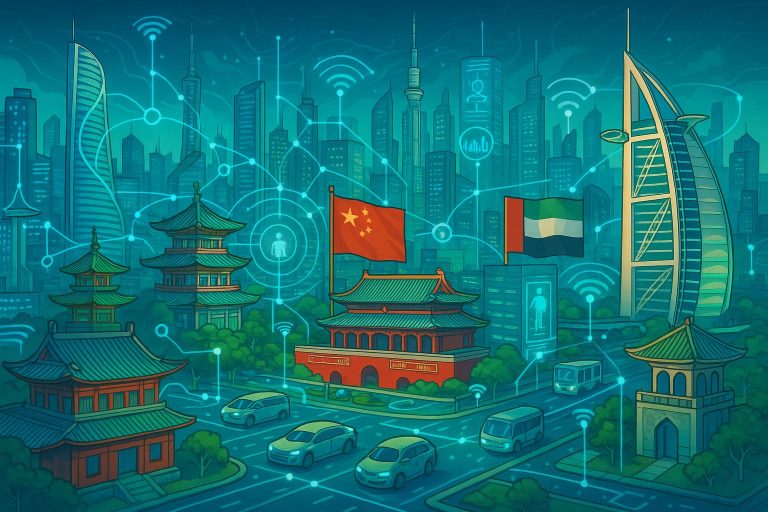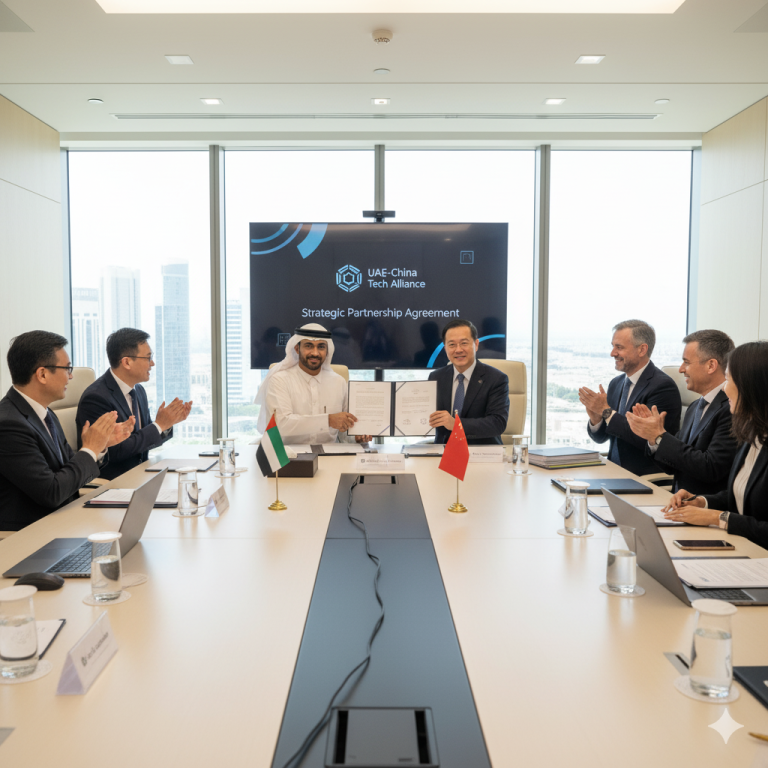AI in the Sky: The Final Frontier of China-UAE Space and Technology Cooperation
Introduction: The New Space Race and the Growing Role of AI in Space Exploration and Satellite Technology
The dawn of the 21st century has ushered in an era of unprecedented innovation, particularly in the realms of space exploration and artificial intelligence. What was once the exclusive domain of a few state-backed giants has now blossomed into a vibrant, competitive arena, often dubbed the ‘new space race’. This contemporary contest is not merely about reaching new celestial bodies or deploying more satellites; it is fundamentally about leveraging cutting-edge technologies, with Artificial Intelligence (AI) emerging as a pivotal force. AI is transforming every facet of space endeavors, from optimizing rocket designs and enhancing satellite capabilities to revolutionizing data analysis for Earth observation and deep-space missions.
In this evolving landscape, the collaboration between nations becomes paramount. Among the most dynamic and strategically significant partnerships emerging is that between China and the United Arab Emirates (UAE). Both nations harbor ambitious visions for their roles in space and technology, and their converging interests in AI present a fertile ground for cooperation. This report will delve into the burgeoning partnership between China and the UAE in space and AI, exploring their individual strengths, existing collaborations, and the immense potential for future joint ventures. The focus will be on how AI is not just an enabler but a core driver of their shared aspirations, pushing the boundaries of what is possible in the cosmos and beyond. This collaboration, characterized by a positive and forward-looking tone, promises to redefine the contours of global space technology and AI innovation, demonstrating that for this partnership, the sky is indeed not the limit.
The UAE’s Space Ambitions
The United Arab Emirates has rapidly ascended as a significant player in the global space industry, driven by a clear vision to diversify its economy and establish itself as a hub for advanced technology and innovation. The nation’s journey into space began with a long-standing interest in astronomy and space sciences, initiated in the 1970s by His Highness Sheikh Zayed bin Sultan Al Nahyan’s meeting with the NASA Apollo moon landing team [1]. This pivotal encounter ignited a national focus on space, leading to key milestones such as the founding of Thuraya Communications (Mobile Satellite Communication Company) in 1997 and Yahsat (Satellite Communications Company) in 2007. The Emirates Institution for Advanced Science and Technology was launched in 2006 (and merged with the Mohammed bin Rashid Space Centre (MBRSC) in 2015), followed by the creation of the UAE Space Agency in 2014 [1].
The UAE’s commitment to space exploration is encapsulated in its ambitious strategies, including the National Space Strategy 2030 and the UAE AI Strategy 2031. The National Space Strategy aims to increase the space sector’s contribution to the national economy and foster capabilities in areas like AI and robotics [2]. The UAE AI Strategy 2031, launched in 2017, seeks to position the UAE as a global AI leader, boost government performance through integrated smart digital systems, and create new vital markets with high economic value [3]. This strategy targets various sectors, including transport, health, space, renewable energy, water, technology, education, environment, and traffic, with specific goals like minimizing chronic diseases, reducing accidents, and enhancing educational desire [3].
One of the most notable achievements in the UAE’s space program is the Hope Mars Mission, which successfully sent a probe to orbit Mars in 2021, making the UAE the first Arab nation to achieve an interplanetary mission. This mission not only showcased the UAE’s scientific prowess but also inspired a new generation of scientists and engineers. Building on this success, the UAE Space Agency announced an ambitious Asteroid Mission, scheduled for launch in 2028. This mission, comparable in scale to the Hope Mars Mission, aims to understand primordial materials, explore asteroid resource extraction (with an estimated $700 quintillion worth of minerals), investigate water-rich asteroids, and study the origins of organic compounds [1]. Khalifa University is a confirmed partner, contributing to payload development in collaboration with the Italian Space Agency, highlighting the mission’s emphasis on international cooperation and academic involvement [1].
The UAE Astronaut Programme further underscores the nation’s commitment to manned space missions and global space exploration efforts. Sultan Al Neyadi’s historic six-month stay aboard the International Space Station (ISS) in 2023, which included the first spacewalk by an Arab astronaut, cemented the UAE’s status as the 10th country to achieve such a feat on the ISS [1].
AI plays a crucial role in these ambitions. The Mohammed bin Rashid Space Centre (MBRSC) has already applied AI to analyze satellite data, assist urban planning, and address agricultural and global disasters [4]. Companies like Space42, an AI space technology company based in the UAE, integrate satellite communication, geospatial analysis, and AI to provide solutions for various applications [5]. The UAE’s vision extends to becoming the world’s first fully AI-powered government by 2027, and it is actively fostering an ecosystem for AI innovation, including launching an open-source AI initiative to compete with global leaders [6, 7]. The establishment of the Mohamed bin Zayed University of Artificial Intelligence (MBZUAI) in 2019, the world’s first graduate-level research AI university, further solidifies the UAE’s commitment to developing AI talent and research capabilities [8].
China’s Space Program
China’s space program has experienced a meteoric rise over the past few decades, transforming the nation into a formidable power in space exploration and technology. Driven by strategic national goals, significant government investment, and a rapidly advancing technological base, China has achieved a series of remarkable milestones, establishing itself as a key player in the global space arena. Its capabilities span the full spectrum of space activities, from human spaceflight and lunar exploration to satellite navigation and deep-space probes.
One of the cornerstones of China’s space ambitions is its human spaceflight program, exemplified by the Shenzhou missions and the construction of the Tiangong space station. The successful deployment and continuous operation of Tiangong underscore China’s capacity for complex orbital assembly and long-duration human presence in space. In lunar exploration, China’s Chang’e missions have achieved multiple firsts, including the first soft landing on the far side of the Moon with Chang’e-4 and the successful return of lunar samples with Chang’e-5. These missions demonstrate China’s growing expertise in robotic lunar exploration and sample return technologies.
Beyond the Moon, China has also ventured into interplanetary exploration with its Tianwen-1 mission, which successfully orbited, landed, and deployed a rover on Mars. This achievement made China only the second nation to successfully land a rover on the Red Planet, showcasing its comprehensive capabilities in deep-space exploration. In satellite technology, China operates a vast constellation of satellites for various purposes, including the BeiDou Navigation Satellite System, which provides global positioning, navigation, and timing services, rivaling GPS and GLONASS. Additionally, China’s remote sensing satellites contribute significantly to Earth observation, environmental monitoring, and disaster management.
Artificial Intelligence is increasingly integrated into China’s space program, enhancing efficiency, capabilities, and the scope of missions. AI is being applied to optimize satellite design, improve product quality, shorten research and development cycles, and reduce costs [9]. For instance, the traditional design process for rocket thrusters, which could take months, can now be compressed to days with AI combined with 3D printing technology, significantly accelerating the iteration and finalization of rocket engines [9]. This integration of AI allows for large-scale parameter optimization, finding optimal and reliable design solutions that surpass human experience, and unleashing generative design potential for breakthrough configurations [9].
Furthermore, AI is revolutionizing satellite operations and data processing. For example, the “Diwei Smart Emergency No. 1” satellite, developed by Zhejiang University and Diwei Space Technology (Hangzhou) Co., Ltd., is China’s first AI-powered satellite with an intelligent operating system. This satellite features an “integrated space-air-ground brain” architecture, enabling semantic understanding, in-orbit identification, intelligent segmentation, intelligent compression, invalid data cleaning, and large model inference capabilities [10]. This transforms traditional remote sensing satellites from merely capturing images to performing real-time computation and analysis in space, significantly improving efficiency and enabling new applications [10]. Alibaba’s Dr. Wang Jian also highlighted the concept of “computing satellites,” which are essentially satellites equipped with AI and computing power, asserting that only by sending AI and computing power into space can humanity truly venture beyond Earth [11]. He noted that a constellation of 12 satellites, launched in May 2025, successfully deployed a full 8B AI model into space, demonstrating the feasibility of in-orbit data processing and inter-satellite communication [11].
China’s space program is characterized by its comprehensive approach, combining robust state-led initiatives with increasing private sector involvement and a strong emphasis on technological self-reliance and innovation. The rapid advancements in AI are further propelling China’s capabilities, making it a crucial partner in the global space community.
Joint Space Missions: An Exploration of the Potential for China-UAE Collaboration in Space Exploration, Satellite Development, and Remote Sensing
The convergence of China’s advanced space capabilities and the UAE’s ambitious vision for space exploration creates a fertile ground for significant joint ventures. Both nations recognize the strategic importance of space and AI, and their complementary strengths pave the way for a robust partnership in various domains, including space exploration, satellite development, and remote sensing.
One area of immense potential lies in joint space exploration missions. China’s extensive experience in lunar and Martian missions, coupled with the UAE’s successful Hope Mars Mission and upcoming Asteroid Mission, provides a strong foundation for collaborative endeavors. For instance, future lunar or deep-space missions could involve shared scientific objectives, co-developed payloads, and joint data analysis. The UAE’s focus on asteroid mining and understanding primordial materials aligns well with China’s long-term goals of resource utilization in space. Collaborative research and development could lead to innovative solutions for propulsion, life support systems, and robotic exploration technologies, leveraging the expertise from institutions like the Chinese Academy of Sciences’ Micro-satellite Innovation Institute and the UAE’s Mohammed bin Rashid Space Centre (MBRSC).
Satellite development offers another critical avenue for cooperation. China possesses mature capabilities in designing, manufacturing, and launching a wide array of satellites, from communication and navigation to remote sensing platforms. The UAE, with its growing indigenous space industry and companies like Space42, is keen on localizing space technology and building its own satellite manufacturing capabilities. A partnership could involve technology transfer, joint satellite manufacturing facilities, and co-development of next-generation satellite platforms. The recent collaboration between Beijing Micro-light Aerospace Technology Co., Ltd. and UAE’s Leap71, focusing on applying Leap71’s “AI+Computational Engineering” technology to optimize the design of Micro-light’s rocket engines, exemplifies this potential [12]. This partnership aims to significantly shorten R&D cycles and enhance performance through AI-driven generative design, showcasing how AI can revolutionize satellite and rocket development [12].
Remote sensing and Earth observation are areas where AI can profoundly enhance the utility of satellite data, and thus present significant opportunities for China-UAE collaboration. Both nations have extensive remote sensing satellite networks, and combining their data streams with advanced AI analytics could yield unprecedented insights. Joint projects could focus on developing AI algorithms for processing vast amounts of satellite imagery, improving resolution, detecting subtle environmental changes, and creating predictive models for various Earth-bound phenomena. This would not only benefit both countries but also contribute to global efforts in climate change monitoring, disaster management, and sustainable development.
Furthermore, the establishment of joint research initiatives and talent exchange programs is crucial for fostering long-term cooperation. Institutions like MBZUAI in the UAE and leading Chinese universities and research centers can collaborate on cutting-edge AI research applied to space. The involvement of Chinese academics on MBZUAI’s board and advisory board, such as Andrew Chi-Chi Yao from Tsinghua University and Dr. Wan Limin from Alibaba, already highlights existing educational and research partnerships [8]. Joint workshops, forums, and academic exchanges, such as the “Aerospace and Ocean Advanced Science and Technology Forum” where scholars from China, the UAE, and other nations discussed AI’s role in space and ocean research, are vital for sharing knowledge and fostering innovation [9]. The call for a new paradigm of international cooperation in the satellite field, emphasizing an “education-to-application” chain, resonates strongly with the potential for China-UAE collaboration [9].
AI for Earth Observation: How AI is Being Used to Analyze Satellite Data for Applications in Climate Change, Urban Planning, and Resource Management
Artificial Intelligence is rapidly transforming the field of Earth observation, enabling unprecedented capabilities in analyzing vast amounts of satellite data. This revolution is particularly pertinent for countries like China and the UAE, which are investing heavily in both space technology and AI. The application of AI to satellite data is yielding critical insights for addressing global challenges such as climate change, facilitating sustainable urban planning, and optimizing resource management.
In the context of climate change monitoring, AI-powered analysis of satellite data provides a powerful tool for tracking environmental shifts with remarkable precision. Satellites equipped with AI can monitor changes in ice caps, sea levels, deforestation rates, and atmospheric composition more effectively than traditional methods. AI algorithms can identify subtle patterns and anomalies in multi-spectral and hyper-spectral imagery, allowing scientists to detect early warning signs of climate-related disasters, assess the impact of extreme weather events, and model future climate scenarios. For instance, AI can process data from synthetic aperture radar (SAR) satellites to monitor glacial melt and sea ice extent, providing crucial data for climate models. Similarly, AI can analyze satellite images to quantify carbon sequestration in forests and agricultural lands, aiding in carbon accounting and the development of climate mitigation strategies.
Urban planning and development are also being revolutionized by AI-driven Earth observation. As cities expand and evolve, accurate and up-to-date information on land use, infrastructure, and population density is essential. AI algorithms can automatically classify land cover, detect changes in urban sprawl, map transportation networks, and monitor construction progress from satellite imagery. This capability allows urban planners to make data-informed decisions, optimize infrastructure development, manage traffic flow, and ensure sustainable growth. For example, AI can analyze night-time lights data to assess economic activity and population distribution, or identify informal settlements to guide humanitarian efforts. The UAE’s “Dubai 10X” initiative, which includes smart city solutions, and China’s extensive smart city projects, both leverage AI and satellite data for efficient urban management [8].
Resource management, particularly in agriculture and water, benefits significantly from AI applied to satellite data. In agriculture, AI can analyze satellite images to monitor crop health, predict yields, detect pest infestations, and optimize irrigation schedules. By integrating data on soil moisture, vegetation indices (like NDVI), and weather patterns, AI models can provide farmers with precise recommendations, leading to increased productivity and reduced resource waste. For example, Diwei Space Technology’s AI algorithms, deployed on Chinese satellites, have achieved over 98.9% accuracy in counting trees, demonstrating the potential for AI in precise agricultural monitoring [10]. For water resource management, AI can track water levels in reservoirs, monitor snowpack in mountainous regions, detect leaks in pipelines, and assess water quality. This is particularly vital for arid regions like the UAE, where water scarcity is a critical concern. AI-powered satellite data can help in identifying new water sources, managing existing ones more efficiently, and predicting drought conditions.
Beyond these specific applications, AI for Earth observation also plays a crucial role in disaster management and humanitarian aid. AI algorithms can rapidly process satellite images during and after natural disasters (e.g., floods, earthquakes, wildfires) to assess damage, identify affected areas, and guide emergency response teams. This real-time information is invaluable for saving lives and coordinating relief efforts. For example, AI can automatically detect changes in infrastructure or landforms caused by an earthquake, providing immediate situational awareness to first responders.
The collaboration between China and the UAE in this domain can lead to synergistic outcomes. China’s advanced remote sensing satellite technology and AI development, combined with the UAE’s strategic location and strong commitment to AI innovation, can create a powerful platform for Earth observation. Joint research and development in AI algorithms for satellite data analysis, shared data platforms, and collaborative projects focusing on regional environmental challenges can significantly advance both nations’ capabilities and contribute to global sustainability.
Conclusion: The Sky is Not the Limit for the China-UAE Partnership in Space and AI
The burgeoning partnership between China and the United Arab Emirates in space and artificial intelligence represents a compelling narrative of ambition, innovation, and strategic collaboration. Both nations, driven by distinct yet complementary national objectives, are rapidly ascending as global leaders in these critical domains. The UAE, with its audacious space missions like the Hope Mars Mission and the upcoming Asteroid Mission, coupled with its comprehensive AI Strategy 2031 and institutions like MBZUAI, is transforming itself into a vibrant hub for advanced technology. China, on the other hand, showcases a formidable and rapidly advancing space program, marked by human spaceflight, lunar and Martian exploration, and a sophisticated satellite infrastructure, all increasingly powered by cutting-edge AI applications.
The synergy between their respective strengths is undeniable. China’s mature space technology and robust AI research capabilities provide a powerful foundation, while the UAE offers a dynamic environment for innovation, significant investment capacity, and a strategic gateway to the Middle East and Africa. This report has highlighted several key areas of cooperation, from joint space exploration missions and collaborative satellite development to the transformative role of AI in Earth observation. Initiatives such as the partnership between Micro-light Aerospace and Leap71 for AI-driven rocket engine design, and the “Diwei Smart Emergency No. 1” satellite’s in-orbit AI processing capabilities, underscore the practical and innovative dimensions of this collaboration [10, 12]. The ongoing academic exchanges and forums further solidify the intellectual bedrock of this partnership.
Despite geopolitical complexities and external pressures, the China-UAE partnership in space and AI continues to deepen, driven by mutual benefit and a shared vision for technological advancement. For the UAE, China represents an indispensable partner, especially in areas where access to Western technology might be restricted [8]. For China, the UAE offers a strategic partner for expanding its global technological footprint and fostering international collaboration in critical high-tech sectors. The positive tone that characterizes this relationship is a testament to the shared belief that cooperation, rather than competition, is the most effective path to progress in the vast and challenging frontiers of space and AI.
Looking ahead, the potential for this partnership is boundless. Further collaboration in areas such as space-based solar power, asteroid resource utilization, advanced robotics for space applications, and the development of ethical AI frameworks for space governance could redefine humanity’s presence beyond Earth. The integration of AI into every layer of space activity—from mission planning and spacecraft autonomy to data analysis and new scientific discoveries—will continue to accelerate, making space endeavors more efficient, cost-effective, and ambitious.
In conclusion, the China-UAE partnership in space and AI is not merely a bilateral arrangement; it is a significant force shaping the future of global technology and exploration. It demonstrates how nations with diverse backgrounds can unite to pursue common goals, pushing the boundaries of human ingenuity. For this dynamic collaboration, the sky is not the limit; it is merely the beginning of an expansive journey into the final frontier, powered by the boundless potential of artificial intelligence.
References
[1] Stars of the Desert: UAE’s Pioneering Role in Space Exploration. (2024, September 25). Space Ambition. Retrieved from https://spaceambition.substack.com/p/stars-of-the-desert-uaes-pioneering
[2] The U.A.E.\’s Growing Space Sector. (2024, December 10). US-UAE Business Council. Retrieved from https://usuaebusiness.org/wp-content/uploads/2024/12/SectorUpdate_SpaceSector_Web.pdf
[3] UAE Strategy for Artificial Intelligence. The Official Portal of the UAE Government. Retrieved from https://u.ae/en/about-the-uae/strategies-initiatives-and-awards/strategies-plans-and-visions/government-services-and-digital-transformation/uae-strategy-for-artificial-intelligence
[4] 阿联酋宇航员|“阿联酋已制定雄心勃勃的太空计划”. DubaiRen.com. Retrieved from https://www.dubairen.com/133957.html
[5] Space42与ICEYE宣布成立合资企业,将卫星制造引入阿联酋. (2024, December 9). China Aerospace. Retrieved from https://www.chinaerospace.com/article/56238
[6] The UAE has global AI ambitions. And a long-term strategy to match. (2025, July 28). Fast Company Middle East. Retrieved from https://fastcompanyme.com/technology/the-uae-has-global-ai-ambitions-and-a-long-term-strategy-to-match/
[7] United Arab Emirates Joins U.S. and China in Giving Away Open-Source AI. (2025, September 9). The New York Times. Retrieved from https://www.nytimes.com/2025/09/09/technology/uae-emirates-ai-open-source.html
[8] China-UAE Relations in Artificial Intelligence. (2024, August 11). MEPEI. Retrieved from https://mepei.com/china-uae-relations-in-artificial-intelligence/
[9] 【文汇报】当卫星遇上人工智能,会擦出怎样的火花. (2024, September 10). Chinese Academy of Sciences Micro-satellite Innovation Institute. Retrieved from https://microsate.cas.cn/xwzx/mtsm/202409/t20240910_7342705.html
[10] 计算卫星出海故事:地卫二如何“智驭太空”? (2024, June 27). BMR Online. Retrieved from http://www.bmronline.com.cn/index.php?m=content&c=index&a=show&catid=23&id=11654
[11] 阿里王坚最新9大论断:只有把AI和算力送入太空,人类才可能真正走出地球. (2025, September 11). iyiou.com. Retrieved from https://www.iyiou.com/analysis/202509111108788
[12] 科技跨境合作:微光启航与阿联酋Leap71共推AI驱动商业航天革新. (2025, August 31). China Aerospace. Retrieved from https://www.chinaerospace.com/article/82730







